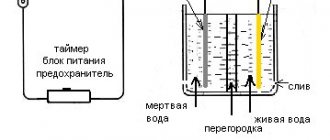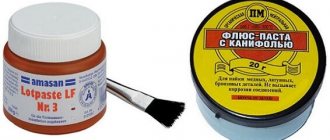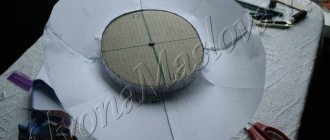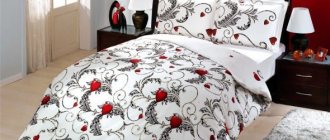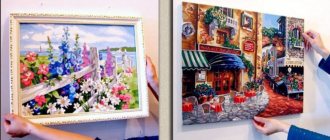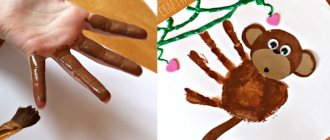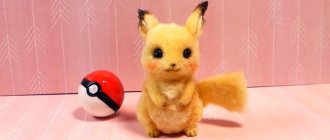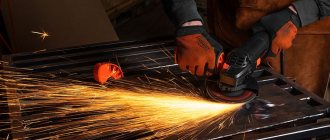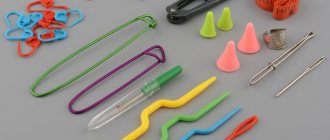Bamboo belongs to the genus of evergreen perennials. This is a grass, but its properties are close to wood. There are three varieties of ordinary bamboo: golden, green-trunked and three-meter (Bambusa vulgaris var. Wamin).
Bamboo is widely used in construction and medicine. The fiber is used in the clothing, textile, wood, pulp and paper and automotive industries as biofuel. In the countries where this plant grows, they say that a person’s entire life is connected with it - from birth to death. Gradually, bamboo furniture and crafts, panels, flooring and even bamboo parquet are becoming popular not only in countries where this unusual grass grows, but throughout the world.
What can be made from bamboo
In southern countries I have seen many useful things made from bamboo, please tell me how this material can be used to decorate a garden plot.
T. Petrova, Korolev
Decorative structures made from bamboo are popular all over the world, but are not yet widespread in regions with cold climates.
EVERYTHING YOU NEED FOR THIS ARTICLE IS HERE >>>
Although herbaceous bamboo species are native to the tropics, some woody species are adapted to life in colder, temperate regions. Representatives of the Sasa genus are adapted to the conditions of the Kuril Islands and Sakhalin.
Bamboo for summer cottages up to the Moscow region (with shelter for the winter) - Kuril sasa (sasa) 0.3-2 m high and fargesia (mountain Chinese bamboo)
. As a rule, frost-resistant bamboo can withstand temperatures down to -20 ° C.
Unconventional methods of using bamboo
In addition to the examples already discussed in detail in this article, such as bamboo wallpaper, blinds, mats and other things, there are also rarer options, which, however, are very impressive.
- Panel on the wall
The production of such a panel should, of course, be left to professional artists. Those, by combining panels of different weaves with bamboo stems, can create a real work of monumental and decorative art that can decorate any apartment.
Bamboo decorations add a little variety to the interior of the room
- Decorative elements highlighting the design
It is unlikely that anyone will actually put a modern reinforced concrete floor on bamboo columns. However, decorative columns, beams, and stair railings made of this material make the space sound new. Therefore, they are sometimes used to enhance the feeling of lightness and closeness to nature.
- Camouflage and protection
The stem of this plant, if cut in half, can be used as a plinth to hide the junction of wallpaper and parquet. Or in order to disguise pipes, communications, wiring, while protecting them from moisture, temperature changes and mechanical damage.
Bamboo is everywhere
Massive flowerpots with bamboo decorate the front entrance of a country house, terraces and patios. The fairly frost-resistant and slow-growing Shibataea kumasaca
(aka
ruscifolia, Bambusa aureostriata, Bambusa kumasaca, Phyllostachys ruscifolia, Sasa aureostriata
). It has a number of advantages - it is cold-resistant, decorative, relatively compact, and does not grow excessively.
In Europe, one of the Japanese variations of bamboo is most common: Bambusa fortunei - Fortune bamboo
(found under the names
Arundinaria fortunei, Bambusa variegate, Sasa variegate
), with relatively low, graceful stems with variegated leaves.
Types of fabric
Types of bamboo fabric depend on the production method:
Bamboo linen
It is made mechanically and is considered more environmentally friendly. This material is more expensive due to complex and slow production, but is higher in quality. Bamboo linen is more uneven and rough to the touch.
Bamboo viscose
Its second name is artificial bamboo silk. This material is made chemically, so its price is lower. It is softer and silkier than bamboo linen.
Bamboo as a unique material
In Indochina Bambusa tulda
grows by 22 m in a month. In many countries of the world, bamboo is the most important industrial crop, not inferior to the coconut palm: as a building material, bamboo provides 25 times more raw materials than the growth of tree wood.
Due to their rapid growth, the trunks do not accumulate harmful substances - this is an absolutely clean and hypoallergenic eco-material that is completely renewable without additional planting when cutting down is limited.
These plants have a phenomenal growth rate: in an hour they rise to 5 cm, in a day - more than 90 cm. The Japanese claim that by looking at bamboo, you can see how it grows. has a record speed - 120 cm per day
.
Tree-like bamboos reach a height of more than 40 m and a diameter of up to 0.3 m, forming huge forests on the planet.
Light and durable bamboo fishing rods are very popular among fishing enthusiasts.
Fabric composition and its properties
Bamboo fabric contains bamboo fibers processed in various ways. The resulting materials differ from each other, but have some common properties:
Natural origin. The fabric is made only from natural raw materials.
Hygroscopicity. It absorbs and evaporates moisture well, avoiding inflammation and skin irritation.
Breathability. The special structure of the fabric allows the skin to breathe.
Protects against UV radiation.
High strength, even when wet.
Softness and elasticity of the fabric.
Hypoallergenic due to natural origin.
The material does not fade for a long time and retains its brightness even after many washes.
Cotton wrinkles less and drapes easily due to its softness.
Durability in use.
Only pros
Among plants, the universal bamboo has no equal in its range of uses. It is cheap, has almost the same manufacturability as wood, and its strength exceeds that of most tree species. Bamboo products are easily converted into compost.
Popular in low-rise construction: a simple and ideal material with high fire resistance provides greater thermal insulation, sound insulation, and high comfort. It provides pleasant opportunities for creativity - a variety of trunk diameters (1-15 cm), ease of cutting when adjusting the length, elasticity and elasticity for creating curved shapes.
The smooth, fibrous structure of the trunks, various colors (white, yellow, green, almost black) are ideal for finishing surfaces and creating furniture. Bamboo combines and harmonizes with natural materials - clay, straw brick, wood, stone, lime, cement, hemp and palm ropes.
Features of how bamboo finishing works in the interior
What makes people choose bamboo finishes over all other alternatives? Of course, this is both the environmental friendliness of bamboo and its wonderful properties, which were already mentioned above. However, there is another important aspect. What visual effects bamboo cladding can achieve. Warm, with a unique structure that is pleasing to the eye, it makes the surrounding space more rich in details. Bamboo strips give the room rhythm, dynamics and pronounced graphics. In other words, bamboo is a material that has very rich artistic possibilities. Using it in one way or another you can:
- visually expand the room;
- increase its height;
- place compositional accents.
Bamboo in the interior looks very beautiful and unusual
Abundance of opportunities
New wood processing technologies make it possible to make almost everything from bamboo that was traditionally made from wood.
Light, rigid and very durable wood is used to build houses, summer playgrounds, kitchens and green theatres, outbuildings, beach bungalows, small platforms and rafts, bridges, and water pipelines. Lightly bent bamboo trunks are joined together to form arched structures that support the shed roofs. Bamboo is used for scaffolding, reinforcement and formwork. In temperate zone gardens, bamboo is affordable and is used where a small amount of material is required: gazebos, pergolas, trellises, decorative trellises, supports for climbing and climbing plants, supports for flowers, fences.
Country houses are equipped with bamboo products - overhead stairs to the roof, extension ladders, water gutters, lamps, wind chime pendants, blinds, curtains, carpets, durable and light garden furniture, greenhouses - shades, household utensils - flowerpots and containers for garden and indoor plants, wicker baskets, dishes, mats, etc. Various tools with bamboo handles (rakes, paint brushes, spatulas) are suitable for gardening.
Lucky bamboo, Chinese bamboo, is Dracaena Sandera, which is not related to bamboo, but is very reminiscent of bamboo stems in its rounded shape and green color.
In the garden, bamboo is used to make supports for climbing plants.
In India, bamboo is a symbol of friendship.
Today, bamboo is organically integrated into various areas of garden design, without a strict ethnic focus.
What interiors is it suitable for?
Technologies do not stand still, and today bamboo can be used in decoration, as far as imagination allows. If you need to add a little exoticism to your interior, bamboo trunks in a horizontal or vertical position will look very stylish. They can serve, for example, as an interior partition or a kind of delimiter in a room. For interior decoration of the house, you can use bamboo panels, and a rolled sheet of thin slats on a fabric basis will effectively highlight the wall in the recreation area.
To add products made from this amazing herb to your interior, you need to choose the right decorative elements.
Features of using bamboo in the interior of a room:
- East style. Feel free to experiment. This material can be everywhere: blinds or curtains, ceilings and parquet, wallpaper, furniture and all decorative accessories.
- Ethnic style. And in this case there is room for fantasy to run wild. The material can be used as partitions or decorating stairs (but if there are small children, you need to be careful with bamboo trunks). Also - for finishing walls, floors, ceilings, as a set for a bedroom, kitchen, living room.
- Classic style. You need to be careful not to spoil the overall picture. It is better to use only minor elements. Bamboo parquet is very suitable - it will add discreet nobility to the interior.
- High-tech style. The following combination will look harmonious: parquet flooring, window blinds and additional accessories in the form of crafts on the shelves and a variety of bamboo lamps.
- Japanese style. You can choose fabric-based curtains, interior wall decoration, furniture and accessories. The main rule here is simplicity, modesty and restraint.
The design of the room must be thought out to the smallest detail so that upon returning home a person has a feeling of peace, tranquility and harmony.
DIY from bamboo
Exotic bamboo poles are cheaper than certain types of construction wood. It is beneficial to use them in subsidiary farming. Bamboo trunks are sawed with a fine-toothed metal hacksaw, holes are drilled and connected with special staples or strong hemp rope knots. If its wood is heated with a small gas burner, it bends in the desired direction, and after cooling it retains its shape.
In order to give the desired shape to the bamboo, it is heated by rotating it over steam or in an oven
For an “ethnic garden” you can make stairs, benches, lattice fences, plant supports, and pergolas with your own hands.
The outer layer (0.5-1.5 mm) of the stem is smooth, hard and dense, it is difficult to leave a scratch on it.
Product Features
On sale you can find whole bamboo poles of different diameters, its halves (a trunk cut vertically), and pressed slabs.
The thickness of the plant varies from 0.5 to 20 cm. Bamboo is a hollow grass that has an attractive texture that does not require additional decoration. The color of the furniture remains natural, preserving the beauty of the plant stem. Therefore, bamboo furniture is a real interior decoration.
Bamboo interior items are made by hand, so their cost is quite high. And the material in the form of hollow plant trunks is affordable. Exotic stems can be less expensive than many common wood species, such as oak.
It is beneficial to use them in your own bed or table production.
Bamboo furniture should not be placed near heating appliances. Most often, to protect against climatic influences, those located outdoors need to be varnished.
The herbaceous inhabitant of Asian forests is distinguished not only by its unusual appearance, but also by the peculiarity of the installation of products made from it. Regardless of what you need to make: a picture frame or bamboo furniture, you need to know the following rules:
- Bamboo trunks are not connected to each other using screws and nails. For this purpose, special staples are used. Another equally popular way to make bamboo furniture is to tie the pieces with strong knots of hemp rope.
- You need to cut bamboo poles with a fine-toothed metal hacksaw. If you use a regular wood saw for this purpose, the logs will crumble.
- The structure is connected using holes drilled in thicker trunks. It is important to learn how to combine plant elements at right angles.
- If exotic wood is heated, it will bend in the desired direction. This makes it possible to make curved armrests, headboards and table legs. Do not overheat the wood: it may become charred. It is impossible to bend the pole at a right or acute angle: it will break.
- In the finished product you need to drill holes with a diameter of 1.5 mm. This will allow the wood to breathe and increase its service life.
- It is better to wrap the log with tape at the place of cutting. This will help make a smooth edge and avoid damage.
Thick stems are used for load-bearing structures of furniture or for interior elements: partitions, columns, etc. Thinner stems and bamboo strips can be seen in additional elements of the structure. Wicker furniture or parts thereof are made from bamboo rods. Slabs of pressed plant trunks preserve its texture. They are used to make countertops, bed bottoms, and closet partitions.
Return to contents
Traditions
Bamboo is an excellent material for landscape stylizations - African, Chinese, Japanese,
where they give the garden a natural feel. In China, bamboo is a symbol of material well-being and career growth, nobility, longevity and fortitude. It is believed to absorb and neutralize negative energy.
Bamboo shingles and fuel are the basis of rural life in China. When assembling roofs that resemble slate in shape, the stems are cut lengthwise, and the resulting halves of the tubes are laid in 2 layers.
In Japan, bamboo is a symbol of purity due to its straight growth and fresh green color of shoots and foliage. Thick bamboo tubes are used as containers for bulk materials and liquids, like flasks.
For convenient watering of flowers, use a bamboo gutter
The slender, often branching, often tall stem of woody plants, which carries an aerial crown of leaves, is valued as a building material. The most famous is common bamboo (Bambusa vulgaris)
.
Bamboo fiber
Due to the special properties of this type of fiber of plant origin - softness, natural shine and silkiness, high hygroscopicity and breathability, hypoallergenic and antimicrobial effects - products made from it have gained enormous popularity in recent years. Today you can find bamboo towels, bed linen, underwear, and hosiery on sale.
There are two technologies for obtaining fiber from bamboo.
- A mechanical method similar to that used for processing flax or hemp. Here, plant materials are treated with special enzymes, as a result of which they soften. After this, fibers are extracted from it by combing.
- A chemical process similar to that used in the manufacture of artificial viscose fiber. In this case, the shoots of young plants are crushed and treated with alkalis to obtain a viscous solution. It is then pressed through dies - plates with tiny holes. In this way, a fiber is formed, which is then placed in an acidic environment to harden the composition and neutralize the alkali. This method is used more often because it is characterized by a high production speed.
Yarn is obtained from the finished fiber in the usual way: it is then used to make woven or knitted products.
Thus, bamboo is a unique plant material, characterized by environmental friendliness, high renewal rate, and easy processing, due to which it is used in completely different areas of industry and production. It is not for nothing that in many Eastern teachings this plant symbolizes health, joy, longevity and indomitable vital energy.
Bamboo crafts
A home craftsman can make things with his own hands from bamboo trunks that will be useful and functional in his garden plot and apartment/cottage. In order for them to look at the level of the best industrial designs, two conditions must be met: - the design of the craft must be appropriate; — the processing of parts and their connections must be precise, and coating with varnish or impregnating composition should not worsen, but improve the natural appearance.
An example of glue joints on an antique bamboo chair
It’s easy to make such a bamboo ladder yourself
Do-it-yourself items that can be used at the dacha include ladders, ladders to the roof, benches, gazebos, and fences. In the apartment there are frames for paintings and photographs, trellises (pyramids) for supporting climbing plants and other things.
In a regular bicycle, you can replace the metal frame with a bamboo one, leaving only the old joints. This will make it more enjoyable to drive thanks to better shock absorption and a smoother ride. New parts must have no less strength than the ones being replaced, because a bicycle experiences frequent and fairly strong vertical loads when riding.
So, a small list of bamboo crafts that are not very difficult to make and that will be useful in the household, apartment or country house:
To make souvenirs from bamboo, it is worth studying Feng Shui and following its recommendations. A well-made imitation of the East will be almost indistinguishable from the original crafts.
Before designing a craft, it is useful to familiarize yourself with the properties of bamboo wood. Its density is 900 kg/m3, and its hardness is about 4.7-4.9 units on the Brinell scale. The outer layer of the stem has a thickness of 0.5-1.5 mm. It is the hardest and most dense in the entire stem. It is smooth on the outside and yellow in color. It is quite difficult to leave a scratch on it. Due to its structure, the bamboo stem is especially strong in the longitudinal direction. This advantage “comes sideways” in another way. Bamboo often cracks in the longitudinal direction, especially when handled incorrectly with tools.
Snowdrops, hyacinths, daisies.
—
Tags
—Categories
- Humor-Jokes-It's interesting-Movie (103)
- Fragrances (28)
- PICNIC (24)
- My photo workshop (8)
- Cookbook (1232)
- Salad, appetizer, savory pastry (551)
- Sweet (474)
- Hot (178)
- Handicrafts-hand made (730)
- magazines (101)
- Hair bows (5)
- Women's secrets-Beauty Secrets-Living cosmetics (366)
- Cozy home-Interior-hand made-Useful tips (482)
- Healthy lifestyle-Health menu-Diets-Sports (363)
- Flowers-Landscapes-Cottage-Nature (544)
- Photo art—Illustrations—Postcards—Interesting pictures (607)
- Photo. (303)
- Artists (73)
- Lovely. (19)
- Talismans-Money-Legends-Divination-Desires (259)
- The East is a delicate matter (58)
- Oriental dishes (35)
- Travel-Architecture-Wonderful World (207)
- Parables-Aphorisms-Clever thoughts (302)
- Animals (219)
- Fashion-Jewelry-Carnival-Costumes (101)
- Saint Petersburg. (29)
- For graphic editors (34)
- Drawing lessons (17)
- Designer things-Dolls (47)
- Self-development-History (105)
- For Li.ru diaries (58)
- Internet Work-Links (22)
- Interesting video (18)
- Music (15)
—Search by diary
—Subscription by e-mail
—Broadcasts
-Statistics
Tuesday, July 02, 2013 09:31 + to quote book
"Bamboo of Happiness"
How to grow "bamboo of happiness"
In China, there are centuries-old traditions and customs associated with the “bamboo of happiness.”
According to the teachings of Feng Shui, the “bamboo of happiness” brings health and happiness, financial well-being to the inhabitants of the house, promotes the flow of positive energy, maintains a good mood, strengthens friendships and love relationships and ensures longevity.
The Chinese place several shoots of the “bamboo of happiness” in a floor vase at the entrance to the house, thus showing respect to the guest and providing him with a charge of positive energy.
In addition, there is a tradition when a guest is presented with a gift of a stem from a bunch kept by the owner of the house.
Considering the “bamboo of happiness” to be an ideal gift, the Chinese give it for any occasion: housewarming, opening a new company, wedding.
According to ancient custom, Chinese newlyweds present each wedding guest with 3 shoots of the plant - this should be the key to a long and happy marriage for the newlyweds.
The number of “bamboo” shoots in the composition has a certain meaning:
- Three stems - attract happiness.
- Five stems mean wealth.
- Seven stems - bestows good health.
- Twenty-one stems - success in all endeavors.
The composition of 20 twisting stems is called the “Tower of Love.”
Such a gift is regarded in China as a gesture of care, friendship and compassion. To achieve wealth and prosperity, the composition should be placed in the south, east or southeast of the house.
Residents of the Celestial Empire use many methods by which, as they believe, they can further enhance the magical properties of the “bamboo of luck.”
Such “happiness multipliers” are red and gold ribbons used to tie bunches of shoots, transparent glass vases, talismans hung on curls of “bamboo”.
Chinese flower growers are also convinced that pots for “lucky bamboo” should not be simple ones, but must have images of sacred animals, for example, a toad, a panda, a dragon or an elephant.
Growing technique
"Lucky Bamboo" is actually a type of dracaena. To care for this plant, you need to follow several rules.
Although the smooth stem of this plant with spectacular bridges looks like bamboo, its true name is Dracaena Sanderiana. The English “nickname” Lucky Bamboo (in the Russian manner - “Bamboo of Happiness” or “Happy Bamboo”) was assigned to these twisting green shoots not by chance. According to the teachings of Feng Shui, this plant brings success and prosperity to the home.
Technological rules and tools
When making various crafts from bamboo with your own hands, you can get by with simple tools. The main one is a rigid machete-type knife.
When making bamboo crafts, you must adhere to several simple technological rules: - do not drive nails into the trunk; instead, drill holes for screws; - do not overdry the bamboo; to avoid this, coat it with varnish; - create ventilation inside each bend of the trunk in the craft, drilling small holes for this purpose that would be inconspicuous; - when cutting, use saws with small, frequent teeth.
Countries where bamboo grows use the square trunk method by placing the growing trunk in a long, square shape.
Bamboo products in everyday life
This plant is used in the manufacture of dishes and various kitchen items: plates and bowls, cutlery, spatulas and stirrers, cutting boards, mats for preparing rolls, chopsticks. It also uses pressing technology with impregnation of plant components with specialized compounds that are safe in contact with food.
The idea of making dishes from bamboo is not new: traditionally, by cutting out a section of the trunk of a large plant, limited on one side by a partition (pictured), various containers were obtained - cups, glasses, buckets.
In recent years, computer and phone manufacturers, as an alternative to the plastic usually used to make cases, have been using composite materials based on fast-growing Asian cereals. For example, Asus released a “bamboo” laptop. In addition, you can find keyboards, mice, mobile phones, tablets and other electronic equipment in a similar case.
Bamboo is also used to make musical instruments, where this plant can form both cavities for generating sounds (for example, bamboo flutes), and can be used in the manufacture of auxiliary parts: bows, decorative elements.
When it comes to sports and leisure items, the plant in question is associated primarily with ski poles and fishing gear.
Splitting a bamboo trunk
It often becomes necessary to split a bamboo trunk into several longitudinal parts. First you need to split it into two halves. To do this, the knife is placed with the cutting part on the cut of the barrel, then it is lightly hit with a hammer. If there is already a crack in the trunk, then you need to place the knife so that the cut hits it. When the knife has entered the trunk, it is rocked left and right and moved along the trunk. In the same way, each half is divided further in half, and, if necessary, into even narrower strips. The knife should be rigid and have a triangular cross-section. Narrow planks are separated by placing them horizontally on a workbench and securing them with something. For such splitting, you will need another special knife, which, thrusting into the bar, is pulled towards you.
How to make bamboo with your own hands? (Master Class)
There was a batik hanging on my wall. There is a frame that I ordered from the workshop, made to look like bamboo. And when they gave me the papyrus, I wanted the papyrus to have a bamboo frame.
I started looking for bamboo in hardware stores. But alas. In the hardware store there is bamboo of different diameters, but no one sold one stick, they somehow count it in a special way... in bundles, and the result is not cheap... And I don’t need a bundle of bamboo sticks.
I started searching on the Internet - is it possible to make bamboo yourself from something? And I found it. This is where the bamboo secret actually begins))
The fact is that there is no bamboo in my bamboo frame! Now I’ll show you how I personally made bamboo. Maybe the one who posted this idea on the Internet will recognize his brainchild, I’ll be glad to meet you, I in no way claim authorship!
For a bamboo frame you need thin, dense tubes of foil or cling film. The tubes may differ slightly in diameter - this is bamboo, and in nature it can be different.
I cut the tubes, but it seems to me that whole ones are also possible; for example, I saved money because I didn’t have many tubes, and I like it better when the flat side is near the frame.
First fitting.
The stretcher was glued together from 2 corrugated cardboard sheets, the front side was covered with velvet adhesive film, and the back side was covered with wallpaper. On the top crossbar you can see that the sizes of the tubes are different.
Each prepared “stick” was covered with pieces of some kind of wrapping paper (found in bins). I glued jute rope under the paper in several places (future jumpers - bamboo rings). Where there is a difference between the diameters of the tubes, I also wound the thread, having previously glued the tubes together, superimposing the larger one on the smaller one.
Cover the glue-dried tubes with brown putty (I covered everything well with my finger, paying attention to the jumpers).
When the tubes were dry, I carefully sanded them with fine sandpaper. In the places where the jumpers were, I used a brush with brown paint and, without waiting for it to dry, I seemed to stretch the paint away from the jumpers, thereby making the color transition smooth and natural.
Unfortunately, I was carried away by the process and forgot to take a photo, but I think the principle is clear. Who wants a certain color of bamboo (for the interior), paint it with your own shades, I almost didn’t paint it, the putty was brown, plus I stretched the brown paint from the lintels and when varnishing, the color became darker and brighter, so I left this option.
Recommendations for selection and care
Items in the interior should be selected so that they emphasize the individuality of the owner and harmoniously combine with each other.
So, if the furniture is chosen in dark colors, then it is better to make the walls and floor light. If you decide to put a set of bamboo in the dining room, kitchen or living room, then it is better to choose plain soft cushions for the seats, and make cabinets and chests of drawers with wicker inserts.
Bamboo products can be golden, coffee, with dark inclusions and ebony.
This material has many advantages. One of them is his unpretentiousness.
Still, it is necessary to follow certain care rules:
- Bamboo is resistant to moisture, and overdrying (for example, if placed close to heating devices) will lead to cracking.
- You cannot move it from the heat to the cold - the temperature transition must be gradual.
- Do not use cleaning products or soap on furniture. Microcracks may form. It is better to use a special composition.
- Armchairs, stools and other furniture can be used after drying, otherwise they may become deformed.
- It is better to remove dust with a vacuum cleaner.
- Once a year you need to varnish if the furniture is standing outside, in the sun.
- Bamboo wallpaper can only be wiped with a damp cloth.
Without a protective coating, the material can quickly dry out and lose elasticity; it is also very sensitive to sudden changes in temperature.


